It’s honestly quite hard for me to talk about Spitz (スピッツ in Japanese) without gushing. Their songs are probably the catchiest, most well-written folk/pop/rock songs around, right up there with Taiwan’s Wu Bai, Japan’s Imawano Kiyoshiro, the Mekons and maybe also Weezer (name anyone else who knows how to craft a song – Brian Wilson, John Lennon…). Nearly every Spitz song, word and music, is composed by lead singer and rhythm guitarist Kusano Masamune, who is not only a gifted songwriter but has one of the best voices in J-pop – a distinctive sandy wheeze in a relatively high vocal range that wrings out the emotions and sounds great in rockin’ numbers, but even better in ballads. Happily, I’m not the only one outside of Japan who thinks so, but there are not many of us – you tend to find who has been turned on to Spitz only by reading the comments at Amazon.com for their releases; otherwise, the chances of running in to a non-Japanese who’s even heard of this marvellous band that sells out stadiums in Japan every time they tour there may be about a million to one.
The band has 15 full-length major label releases now (and two independent releases), with two EPs, and at my home in Singapore I have all of the major label releases. I will be reviewing them here.
Check out this site for an encyclopedic run-down of song titles from all of the albums, DVDs, singles and indie material from 1988-1990. Also see their fan club, Spitsbergen.
On the band’s 15 releases and 185 songs, I give 83 of them top marks (five stars) in my iTunes ranking.

ST
とげまる - Togemaru, released October 27th 2010, Universal Music Japan – Spitz’s 13th album only has a few standout tracks and many of them sound like clones of previously releases songs, but it’s very pleasant nonetheless. Opening track “Beginner” is regular lumbering rock ‘n’ roll, while “Tankentai” is a bit jauntier, with groovy background vocals. “Shirokuma” (Polar bear) is a cute little number with near-perfect melodies in the verses and chorus, and flawless production, as must be expected from a tight, disciplined band that’s never sounded sloppy. “Koisuru Bonjin” hops and bops and has a nice rocky edge, while “Tsugumi” is a fun mid-paced rocker. “Shingetsu” is probably one of the best songs on the album, it is slow-ish and is dominated by a big catchy piano and semi-drone guitar riff that would make you think of Coldplay – except that Spitz is nowhere near as boring as Coldplay. The verses are wan and spooky, haunting and icy, but with great feeling, and they swell up to that catchy riff. “Hana no Shashin” is some good old country pop with a beautiful melody and chorus and good, drivin’ rhythm. “Maboroshi no Doragon” is a somewhat cheezy rocker, but it’s nice enough. Much MUCH better is “TRABANT”, a superb rocker that is right up there with the best that Spitz has ever done. This song will put you in a trance of joy with its obvious best-song-ever-written driving beat that out-punks punk. I love this song. By the way, for those who don’t know what a “trabant” is, this is East Germany’s two-cylinder answer to the Volkswagen, BMW, Mercedes and Porsche. “Kikasete yo” is a pretty acoustic song that is utterly dominated by the awe-inspiring smokiness of the lead singer’s voice. Find me a prettier song that is sung as well as this one that soars into such a gorgeous chorus! “Enishi” is a bit louder than the rest of the songs on the album, but it’s still just another happy, lite Spitz rocker. “Wakaba” is a sort of frisky rocker that is rather nice, it is a beautiful slow song with a thrilling melody that somehow picks up a big drum beat (I think it would have sounded nicer as a simple song) but is really very very fun and gorgeous. The sleeper hit of the album. “Dondodon” is a bit of a rocker with distorted vocals, but it is ultimately pretty conventionals. “Kimi ha taiyou” is a very nice rock ‘n’ roll number.
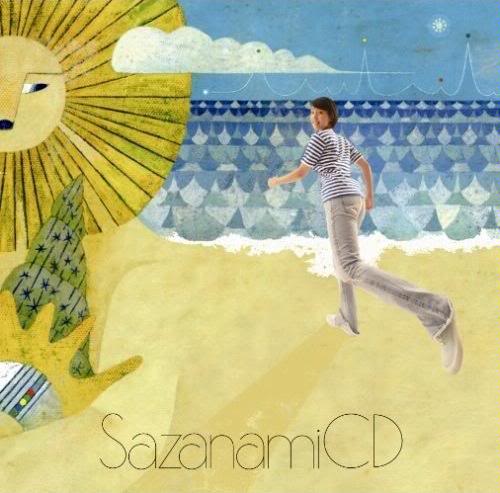
SS
さざなみCD - Sazanami CD, released October 10th 2007, Universal Music Japan – Spitz’s 12th album starts off with an acoustic song that quickly shifts gears to become a rocker – this seems to be a favourite tactic of principal songwriter Kusano. The CD needed a few listenings until I got used to it, rather than any songs leaping out at me – most Spitz CDs will have standout tracks from the very first listening – and had a bit of a “generic Spitz” feel to it, almost as if Spitz has become as same-samey as the Ramones or AC/DC. This album seems to be a bit “rockier” than recent releases, without any real ballads, although opening track “watashi no gita” has some acoustic guitar. Every single song has great guitar sounds, and Kusano’s fantastic whiskey-smoked vocals. Spitz is the best guitar pop around, outclassing boring bands like Coldplay every step of the way. The guitarist has a Gibson Les Paul.
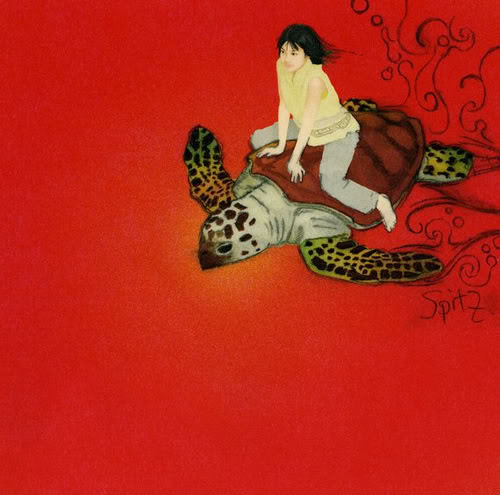
SS
スーベニア - Souvenir, released January 12th 2005, Universal Music Japan – Spitz’s 11th release starts off strong with a rockin’ number “Natsu no uta” that’s busy with electric sounds, while “Arihureta jinsei” is a tender, fast-moving song that opens with ukelele, gets into a swing, adds strings, and builds up into a killer chorus. “Ama’tare Creature” is a monolithic, atonal rocker that needs to find a groove. “優しくなりたいな” is a tender ballad that is really just a bit TOO tender (sorry Kusano-san), and the “echoey room piano” accompaniment is a bit sappy. Never mind, though, it’s followed closely by the Okinawa rock of “ナンプラー日和”, one of the album’s standout tracks. “正夢” is a decent rocker and very catchy, “ほのほ” moves and rocks with great momentum, while “ワタリ” is even faster and pounding. “恋のはじまり” slows things down just a wee bit, ”Jidosha” is a pleasant reggae-inspired number, and “Tatum O’Neill” is a jaunty rocker – I’m just not quite sure what it has to do with Tatum O’Neill. “Kae ni Ikuyo” is a great ballad, despite the welling strings.
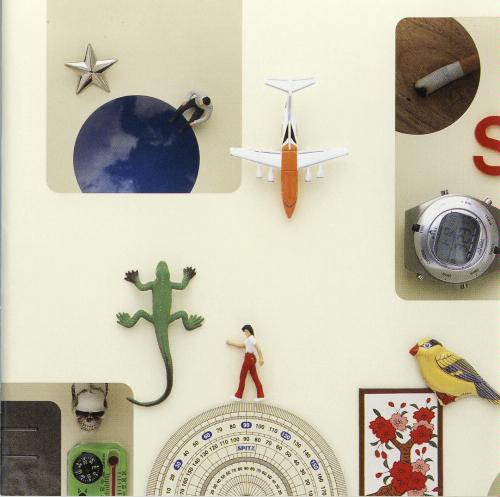
SIIG
色色衣 - Iroiro Goromo, released March 21st 2004, Universal Music Japan – This 2004 release is another odds ‘n’ sods collection (the previous one, 花鳥風月 - Ka’chouhuugetsu, came out in 1999) is mainly B-sides from singles released since that compilation, i.e. between 1999 and 2004, with the three songs found on the “99ep” mini-album (one taken directly from it, and two re-mixed), along with a single previously unreleased track, which closes the album. The opening track is a typically well-written masterful guitar pop song, while “High Fi, Lo Fi” remixed from the 99ep for a cleaner sound is a jaunty rock number; ditto for the next song, while “Sakana”, taken directly from 99ep is sweet, sombre, ballady. “Masorite” starts off jazzy, but then becomes a typically jaunty rocker. Somewhat inexplicable, another version of the song “Memories” – which isn’t a great song to begin with, is here, since it was the B-Side of… “Memories.” “Seishun Ikinokori Game”, the third track from 99ep is a so-so rocker that is slightly longer – it differs from the original by repeating another verse at the end before the fade-out. “SUGINAMI MELODY” is a tuneful ballad that is a bit heavy on the strings, while “Songoku” is a reggae-influenced crunchy number that starts off mellow before picking up steam. “Omiya Sunset” is a pleasant acoustic ballad, while the previously unreleased track “Boku wa Jet” is a groovy, infectious rocker with a punk-like chorus; the song was recorded in 1989, so it’s ancient history for Spitz.

SMR
三日月ロック - Mikazuki Rock, released September 11th 2002, Universal Music Japan – Mikazuki Rock was released in 2002 with 13 songs, the band’s first for new label Universal Music Japan. The opening song on this album, “Yoru no kagetekuru”, basically shows how Spitz is roughly-speaking the Coldplay of Japan, but much… much… much… better. It’s probably their best album-opener. “Mizu iro no matchi” is a charming pop song that my wife has asked me to learn how to play, it’s good. “Mekans no thema” is a good, rockin’ song with nice riffs and a driving pace. “Babaroa” is another Coldplay-like slow-burner with cool basslines, haunting vocal sounds, and a bit of an electronic feel to it. “Low Tech Romantica” is a ho-hum so-so rocker, but it’s followed by another burner, “Hanemono,” which starts off sedately before building up into one of Spitz’s most infectious rockers – this is another fun song to play on the guitar. That’s followed by the sweet “Umi wo Mi ni iko”, which is all about going to the beach, also one of their better songs. “Escargot” starts off with bland-ish riffs, but improves greatly with a rollicking chorus. “Kaede” and “Gabera” are both smooth, sweet tunes, and the album-closers are relatively straight-forward numbers and somewhat unmemorable.
Check out this album’s wicked opening track!
夜を駆ける - “Yoru no kagetekuru”
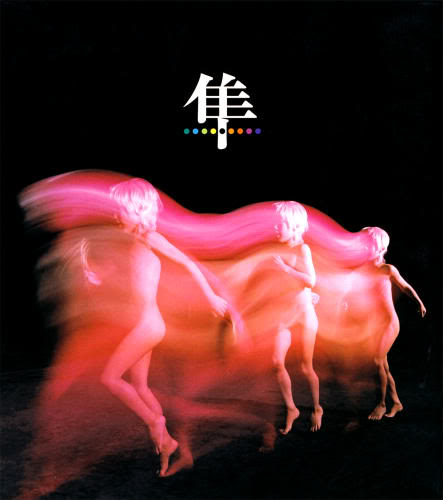
SH
ハヤブサ - Hayabusa, released July 26th 2000, Polydor Records – “Hayabusa”, Spitz’s ninth album starts of strongly: “Ima,” the first of 14 songs, is a decent rocker, but it only sets us up for the second song, definitely one of the band’s best ever, with its jarring opener and the fantastic drum attack and wild infectious choruses (although it’s broken up with a cheezy keyboard solo – nobody’s perfect). “Iruwa” is an atonal rocker, while “Saraba uniform” is a gorgeous ballad. “Amai te” is one of Spitz’s all-time best songs, starting off with simple chords, then going into goregous vocals, and then a heavy, power-ballady chorus. It mixes in slide guitar, and mysterious soundbites in Japanese and Russian (?) that make it a truly mysterious – in a similar way that the Scorpions’ “Born To Touch Your Feelings” is, with its refrain of sexy lady voices from Japanese and Russian and some other languages (check out the video below, from the 5:15 mark) – it’s truly an intriguing song. Enchanting. Having these two extraordinary songs on it probably makes this the best Spitz album to get, in my view – but, of course, they’re all great. The fun continues with “Holiday” (which has nothing to do with the Scorpions classic), and then the wonderful “8823″, a really tied-together all-in-one masterful genius pop song. I don’t know how Kusano does it – he writes almost all of their songs! “Uchu mushi” is a rare instrumental piece, “Heart ga kaeranai” is a gorgeous ballad (again) that makes wonderful use of some very discreet background vocals – lovely, one of this great band’s most beautiful songs. “Memories Custom” is a cheezy retread of one of their aging rockers, “Ore no akai boshi” is a great, dark, moody rocker that starts off with those gorgeous vocals before rocking out with a massive, unfolding riff. The album nears a close with one of Spitz’s best songs, “Je t’aime,” a simple ballad with Kusano singing and unaccompanied on guitar, with some sort of a Chinese er-hu solo. Check it out in the live link below. Final song “Akamu” is pretty good, but a little anticlimactic after “Je t’aime.”

SK
花鳥風月 - Ka’chouhuugetsu, released March 25th 1999, Polydor Records – Compilation of B-sides and unreleased session outtakes, along with newly recorded material (the first two songs) and the re-release of two songs from Spitz’s independently released album “Hibari no kokoro” of 1990, this 1999 release (with songs presented in reverse chronological order) has something for everyone. The hard-cover version of the CD that I got has a booklet inside with lots of geisha pictures, and song credits, along with a loose 24cm x 36cm poster that has an interview with the band printed on the reverse side. The four characters of the cover mean fower-bird-wind-moon, I wonder if each is supposed to represent a member of the band (just like Sonic Youth’s “Experimental Jet Set Trash and No Star” represents each of their members).
Opening track “流れ星” is a very pretty, slow number that is sung in perfect, doleful manner by Kusano, showing off his wonderful voice, it’s a new recording for this CD that goes back to the band’s roots; originally it had a reggae arrangement, but for this re-recording the band decided that this did not sound sophisticated enough for modern tastes, so they re-did it to the current slow number. “Ai no Shirushi” is a well-known song that was written by Kusano for girl-rock band Puffy (i.e. Ami Yumi), the first time Kusano had done so for another band. Okuda Tamio, the Puffy producer (former Unicorn leader and a famous solo recording artist in his own right), had invited them to write for his Puffy project, so Kusano created a new song that also has lyrics that Spitz would have never sung on their own. It’s a bit strange hearing the Spitz version done raw with piano and horns instead of the slick, brash grrrrl-pop of Ami and Yumi. “Speaker”, the B-side for “Kaede”, is good fun, a very nice guitar number with a rousing chorus (a Spitz trademark) that you just want to hear over and over again… and would marvel over the sweet, simple songwriting. “旅人” (a song that was later covered by Cantopop singer Kelly Chan) and “俺のすべて” are decent pop numbers, although these relatively unmemorable B-sides for colossal blockbuster hits “Nagisa” and “Robinson” respectively are actually pretty run-of-the-mill in comparison to the A-side magnificence that preceded them on initial release (ironically, the band thought that “俺ã®ã™ã¹ã¦” was a stronger song than “Robinson”, which they thought was too poppy, especially since it uses the strong 俺, a more macho way of saying “I”; the band wonders what their career would have been like if they had made that the A-side instead of “Robinson”, since most people only took note of Spitz when “Robinson” became a monster hit as a single and in a famous TV drama of the time). “Neko ni naritai”, the B-side of the stellar “Aoi kuruma”, doesn’t start off all that promising but it quickly becomes a catchy, cheerful pop song. According to the band interview that comes with the CD, this is one of the favorite songs of long-time Spitz fans, and in song rankings it is often first place. Ditto for “Kokoro no Soko kara”, which has the added benefit of jaunty, cheezy whistling and horns. While the band nowadays finds this song the least remakable song of theirs on this album, Kusano at the time it was written felt that it would give the band their big break. “Mermaid” is a so-so tune, “Cosmos” has low-end keyboard burbling, a bit of percussion, and a big vocal fix. Apparently, “Cosmos”‘s original title was “Belmondo”, because Kusano had been inspired to write it after watching one of Jean-Paul Belmondo’s movies on TV. It’s a bit on the dull side, but sounds nice nonetheless. “Yasei no tulip”, a previously unreleased out-take from their second album, is probably one of the best songs on the album, a jaunty rocker that goes from one high to another with a jangly refrain and infectious verses and chorus, and a nice bridge too of course – he had it in him from the very start. “Tori ni nat’te” has that cheezy early production value, but it still sounds pretty sharp, it is the first song that the band ever wrote, one year after forming. The last two songs on the CD are the first two songs on the band’s independent CD release of 1990, “Hibari no Kokoro” of 1990, which includes six songs (the band had also put out two full cassette releases, as well as two cassette singles before the “Hibari no Kokoro” independent CD). “O’pai”, the first of two songs, is a great, simple, jangly little pop song with a fun, loud chorus (“o’pai” means breast, and the chorus sort of says “your breasts are the best in the world”). What a wonderful tune! “Toge Toge no ki” is just as funky, it’s hard to believe that these wonderful songs were released as far back as 1990! “Woo-oo-oo-oo genki de ne/ Woo-oo-oo-oo itsu demo.” (Other songs on the Hibari no Kokoro indie CD, not included here – or anywhere else so far as I know – are the title track, “353 Gousen no Uta”, “Koi no Uta” and “Shi nimo no Kurui no Kagerou o Miteita”, the latter of which is translated as “I saw the ephemera of insanity unto death”, which makes me wonder how close the hidden four are to the band’s punk roots; a re-recording of the title track appears on the band’s first album).
Check out the original Puffy release of “愛のしるし” of 1998, followed by the Spitz version of 1999.
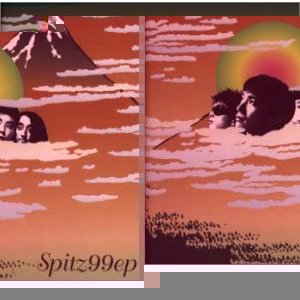
S99
99ep, released January 1st 1999, Polydor Records – Opening number “High Fi, Lo Fi” is a jaunty rock number. “Sakana” is a sweet, sombre, ballad. “Seishun Ikinokori Game”, the last track, is a pretty good rocker with a gorgeous, long solo that sounds technically innovative. The songs were also put on the 色色衣 - Iroiro Goromo compilation that was released on March 21st 2004, placed into the 2, 4 and 7 positions (instead of 1, 2, 3 on this one), but with new mixes for ハイファイ・ローファイ and 青春生き残りゲーム … meaning that the record company doesn’t really need to keep this EP in print.

SFF
フェイクファー - Fake Fur, released March 25th 1998, Polydor Records – Fake Fur… what a great album title. Spitz’s eighth release starts off with a… a lullaby! It then gets rockin’ with a bland-ish tune, before things get a bit more interesting with “Unmei no hito,” a tender ballad. The fifth and sixth songs are excellent, especially “Kaede,” once again a gorgeous ballad in the vein of “Robinson”. “Supernova” is a laid-back rocker, while “Tada Matsu wo matsu” has a summery feel to it. “Xie Xie” is a fun, jazzy number with horns that is fun to learn how to play on guitar (simple chords), and “Scarlet” is a very very very catchy jangly ballad – so easy to fall in love with this song. Album closer “Fake Fur” is an intense, plodding rocker that is definitely one of their best non-ballads on this album.

SIC
インディゴ地平線 - Indigo Chiheisen, released October 23rd 1996 – The opener of Spitz’s seventh release, “Hana Dorobo”, is a rocker that for some reason annoys me with its bland riff, but the follower “Hatsuren crazy” is probably one of their better numbers, a jaunty pop song that has everything it needs. “Indigo no Chiheisen”, also the name of the album, is another great pop song. Do these guys do anything else but write great, jangly, guitar pop songs? Fourth song “Nagisa” is probably one of their top five songs, with burbly keyboards like I’ve never heard before, a great buildup, drums that take on a life of their own, and a chorus that can’t be beat. “Hayate, which follows it, is not so bad for a simple pop song, but it doesn’t have the flourishes of “Nagisa”. “Bunnygirl” is another catchy song that won’t leave your brain, while “Houki sei” is gloomy and timeless. The last song on the disk is “Cherry,” probably the band’s biggest hit after the enduring hit “Robinson.”
By the way, if you don’t believe me about “Nagisa,” check out the song for yourself:

SH
ハチミツ - Hachimitsu, released September 20th 1995, Polydor Records – Spitz’s sixth release is probably one of their best. Title track opener “ハチミツ” is a gorgeous folk rocker with funny lyrics “great lover, honey / strange lover, honey”. “涙がキラリ☆” is a little on the dull side, but it is a well-written song, ditto for “歩き出せ、クローバー”. “ルナルナ” is jaunty and moves along at a good clip, with nice, jazzy guitar work. “愛のことば” and “トンガリ’95″ are nice-enough songs, even if they are a bit uninteresting. “あじさい通り” is a fun pop song that uses strange keyboard sounds, new wave guitar chords and fluid bass, with a great chorus. “ロビンソン” is by far the band’s most famous song, and after all these years it’s still one of their best, with a very interesting riff, pleasant production values, and a soaring chorus – an anthem that can get an entire room of Japanese off their feet. “Y” is a very very beautiful ballad, that’s all I can say about it. “グラスホッパー” is a pretty regular rocker with a cheezy chorus, while “君と暮らせたら” is a so-so pop song.

SST
空の飛び方 - Sora no Tobikata, released September 21st, 1994, Polydor Records – Spitz’s fifth release starts off strong with “Tamago”, and it’s followed by plenty of strong songs. This was the last album that Spitz was NOT a blockbuster band because they still had the smash hit “Robinson” from their sixth release “Hachimitsu” ahead of them. Nevertheless, it has fantastic tunes like “Sora mo toberuhazu,” which has a sweet opening riff that sounds like an early Beatles classic – stunning. Unfortunately, it’s followed immediately by a rare Spitz clunker, “迷子の兵隊”. The fifth song starts off with horns and is a lot of fun, full of Kusano’s sandy vocals and with great production values, so is rocker “Hushishin no penas”. “Raspberry” is good fun, with horns (and a few strings), it’s a jaunty full-on Spitz song, with nice fuzz guitar and clean breaks. “Hechima no Hana” has interesting baroque elements and groovy keyboards, it’s a gorgeous jazz number in some ways and quite inventive in terms of its production values. With some great background vocals, this song has really grown on me over the years, to the point that I’ve become totally enchanted with it (I think it’s the background vocals, they add just the right touch). Stunning.

SC
Crispy! Released September 26th 1993, Polydor Records – Crispy! is the band’s fourth release, and it suffers from some of the rough early production values that they used to have, but on repeated listenings it’s certainly hard to find any songs that are filler. Only the second song, “Natsu ga owaru”, suffers from too many strings (as do a few others, like the welling orchestra that sneaks up on “Kimi dake wo”, and the surging choppy violins of “Kuroi Tsubasa”, which blend with nifty guitars and icky space vocals at the end!), but other songs are just wonderfully textured with the measured pace of lead singer Kusano Masamune’s sandy vocals. Album closer “Kuroi Tsubasa” is one of Spitz’s rare not-so-good songs (the band’s 5th, 7th, and 9th albums also have a few not-so-good songs).
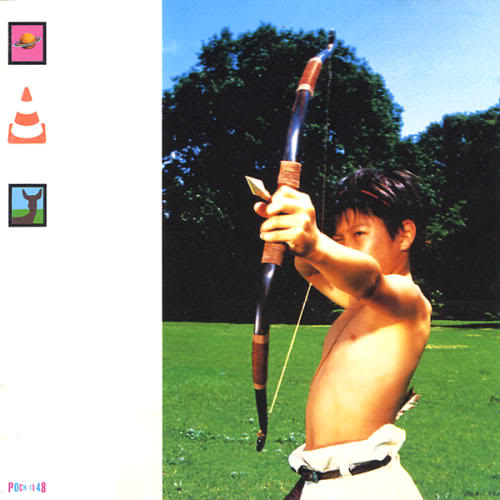
SHK
惑星のかけら – Hoshi no Kakera, released September 26th 1992, Polydor Records - Spitz’s third release starts with the title track “惑星のかけら”, jumping right into a grinding heavy metal intro that kind of makes you scratch your head and say “this is Spitz? Yuck!” But the listener quickly realises that the song is gorgeous and catchy with a really killer chorus. “ハニーハニー” starts off with a lot of noise, but then goes into a sort of rocky quiet/loud tune that sounds rather old. “僕の天使マリ” is a jaunty rocker with a shuffle beat that kind of zips along, but is not all that memorable. “オーバードライブ” is a tight ’70s-style rocker with a lot of guitar flourishes. “アパート” nearly sounds like a Cure song, the way it starts off, but it quickly becomes a standard very well-written Spitz song that puts a great emphasis on arpeggios and guitar work. And now – considering that this CD so far has been the weakest of the first three releases – comes another one of their standout tracks, “シュラフ”, a haunting pop tune that has some wicked flutework at the beginning, and a really magical flute solo (yes, I’m surprised too). “白い炎” is an uninteresting rocker, while “波のり波のり” downright boring. “日なたの窓に憧れて” is a so-so pop/rock song that is heavy on the keyboards. “ローランダー、空へ” is gloomy and grungy, not very interesting; the production adds a lot of echo to the vocals, making it sound more dated than most of the early Spitz songs. The guitar solo is pure cheese, helping it to win the award for the weakest song on the album. The CD closes with “リコシェ号”, a short, interesting rocker with some bizarre electronic sounds in it. Funny – the kid shooting a bow and arrow on the cover looks just a little bit like my son Zen.
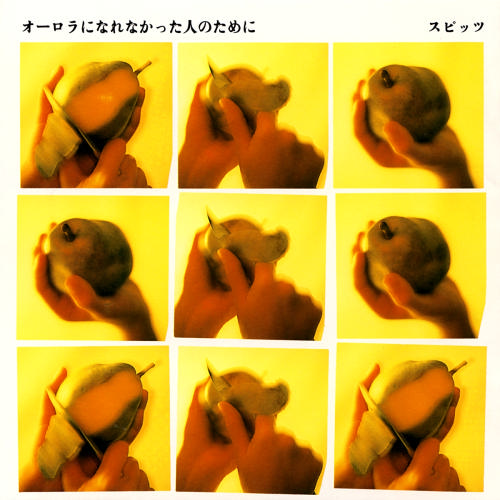
SANHT
Aurora ni Narenakatta Hito no Tame ni EP – オーロラになれなかった人のために EP, released April 25th 1992, Polydor Records – The band released this five-song EP between their second and third albums, and in a way it’s their most experimental release, with a brass section, strings, and noise passages, while making very little use of the bass, drum and guitar – vocalist and songwriter Kusano is the main participant here. The first song, “魔法 Mahou”, (magic), is probably the best, starting out as a nice acoustic pop song, before flaring up with a big brass section, and then moving out with some pretty funky sound effects. “田舎の生活 Inaka no Seikatsu”, (country life), is a simple, pretty song with voice, acoustic guitar and xylophone, strings. “ナイフ Naihu”, (knife), is full of the Spitz trademark shimmering guitar, some bass and drum, but then the song dissolves into pure vocals, picking up again with slow drums, and eventually strings that builds into a heady, simmering swell. Not many of Spitz’s songs are so dominated by Kusano’s smoky voice. At nearly seven minutes, it’s also by far the longest song the band has ever done. “海ねこ Umi Neko”, (sea cat,) starts off with funky bass and keyboard and then busts out into a brass section-led funker. The song indulges in a weird section of dissonance, before getting back on track. “涙 Namida”, (tears), has voice, harpsicord and strings. Yes, it’s pretty weird.

SNTY
名前をつけてやる - Namae wo Tsukete Yaru, released November 25th 1991, Polydor Records – The opening track of Spitz’s second album, “ウサギのバイク”, starts out with mellow la-la-la-la’s and doo-doo-doo-doo’s, a long instrumental intro, and then half way through the short three-minute song the lyrics begin. Perfect guitar pop. “日曜日” is a charming rocker, while title track “名前をつけてやる” is a bit more experimental, with odd sounds, but is ultimately true to guitar pop roots with a rousing chorus. “鈴虫を飼う” is one of the better songs on the album, starting out with a slight balalaika jangly sound, it’s got a gorgeous slightly-slower-than-you-expect feel to it throughout and a phenomenal, gorgeous chorus. One of the band’s first real standout tracks. “ミーコとギター” is a pretty standard rocker, nothing exciting, while “プール” is a pretty standard mellow tune, nothing exciting here either. “胸に咲いた黄色い花” is a punchy rocker with some pretty dodgy production standards – its tune is pretty enough, though. “待ちあわせ” rocks as well, but is a bit monotonal. “あわ” is an unusual tune for Spitz, it is sort of a jaunty boogie tune with a long intro, it’s a lot of fun and has very nice vocals. “恋のうた” is even more interesting – it has a quick vocal start, and then gets into some sort of a Carribean/carnival sounding song. The CD is capped by “魔女旅に出る”, a well-known and catchy pop song that is actually not all that remarkable.
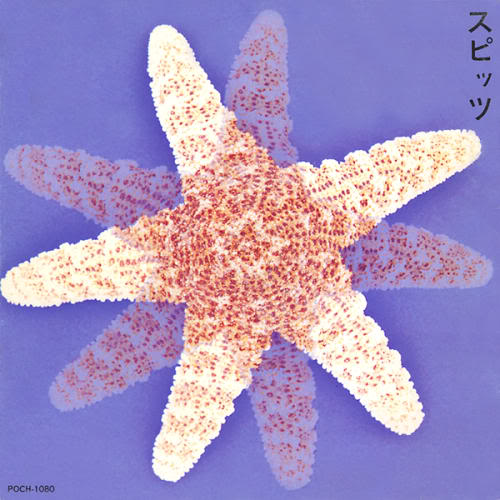
SS
スピッツ - Spitz, released March 25th, 1991, Polydor Records – Spitz’s first album. Although I didn’t really expect Spitz’s early albums to be any good, since some of the production values of the older songs I heard was pretty dated, I did want to get all of them for continuity. I was very pleasantly surprised to find very many very good songs on the first release (although I probably shouldn’t be – good songwriters are usually good from the start… you either have it or you don’t). “ニノウデの世界”, the first song of their major label career, is a rocker as good as any you’d hear on any of their later albums. The fully-formed Spitz sound is instantly recognizable: crunchy riffs, smooth and clear vocals, with great choruses. “海とピンク” is a bit on the dull side, but drives on and on nonetheless and is fine music. “ビー玉” seems to be a bit of an Everly Brothers throwback, real early ’60s sound and a pleasant song with fine vocals. “五千光年の夢” is a punchy, boppy guitar pop song with a simple opening riff and a long “la la la la la la la la” vocal bit that is a bit silly, but not unpleasant. “月に帰る” is not very interesting at the start, but it becomes a very nice vocal tune, before building up into something extraordinary. “テレビ” starts off with a hillbilly vibe that becomes a bit punkish, before changing on cue into a standard well-written, well-produced Spitz song. “タンポポ” starts out with moods sound effects, then majestic power chords, before the voice comes in, probably one of the mellowest song on the album (but not exactly a ballad either). “死神の岬へ” is another lovely mid-tempo rocker, as is “トンビ飛べなかった” (aren’t they all?). “夏の魔物” is a great rocker, followed by the plaintive “うめぼし”, a sweet vocal/acoustic guitar/cello ballad (there always has to be one, it seems). The closing song is the famous “ヒバリのこころ”, a jaunty, galloping number, which had been the title of the indie CD they had released in 1990 just before signing to Polydor and releasing “Spitz” in 1991. Not a stinker among the lot, this could have been an ABBA album. Interestingly, none of the songs on “Spitz” seem to appear on any of the band’s very early indie releases (which includes four cassettes, with 2-7 songs on them, and a 6-song CD) except for the last track, which had been the title of their sole indie CD release, although songs from the early days like “Tori ni natte”, “Oppai” and others did show up on the 1999 “花鳥風月” compilation.
Here’s the band themselves – you don’t see them on their album covers, but there are four guys in the band.

SP-band
About My big bad Spitz page
I made this page as a tribute to Spitz after I realised that there is a dearth of information in English about the band out there and that, since I own probably all of their recorded material, I should do something about sharing this information.
If you wish to write to me with your comments and questions, please drop me a line at peter at hoflich dot com.
You may also wish to check out: